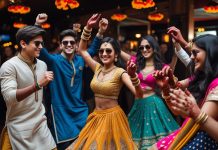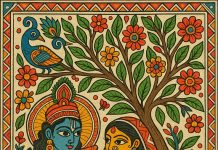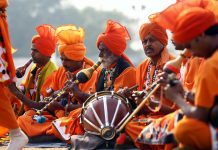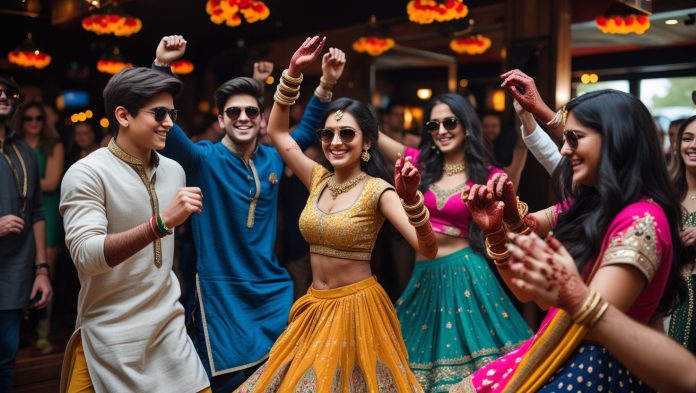Consider a club you visit frequently every weekend, dressed for a party, now transformed into a lively fake sangeet party space with string lights and marigold flowers. Group of friends in ethnic anarkalis, lehengas, and sherwanis, all ready to dance to Bollywood tunes until dawn. The mehendi artist starts working while a photographer clicks away. Everything looks so much like a typical Indian pre-wedding activity, just that this time there is no bride and groom, and certainly, no wedding.
What started as a joke among friends—dancing to Bollywood hits in designer lehengas without a wedding—has become a full-blown cultural trend. From Mumbai’s lounges to Delhi’s chic pubs, fake sangeets are now the go-to parties for young professionals. They offer all the glamour of Indian weddings without family drama, financial stress, or commitment pressure
Rising Trend of Commitment-Free Celebration
The fake sangeet trend points to a deeper shift in how millennials and Generation Z approach traditional celebrations. These are no mere costume parties-they are staged events featuring mehendi artists, traditional decor, professional photographers, and curation of Bollywood tracks. One rents expensive ethnic wear and hires a makeup artist while arranging a choreographed dance extravaganza.
Attendees often say a fake sangeet party is more fun than the actual ones, free from social pressures and family expectations that sometimes overshadow real wedding events.
And there is so much appeal in that. Real sangeets, though joyous occasions, have a laundry list of expectations, family politics, and social pressure that can almost turn a celebration into a stressful burden. Fake sangeets bleed away everything but joy, music, dancing, gorgeous clothes, and that feeling of celebration.
Escaping the Wedding Industrial Complex
The days of dry and dull weddings are long gone in India. Nowadays, sangeets can be as expensive and elaborate as the wedding itself. Families spend months planning these events: coordinating with relatives, working on all the hundreds of names on the guest list, and mingling through the politics of seating and ceremonial roles.
The younger generation is worn out by attending these events. The usual drill is questions about their wedding plans, comparing them to other cousins who’ve already married, and forcing them to pretend that they’re very happy while they are struggling with their own relationship issues or career stress.
Traditional sangeets have become performance stages where youth must endure ongoing assessments about their looks, together with their dancing abilities, love life and career progress. The fake sangeet format preserves traditional celebration elements while removing the customary evaluation process.
The Psychology behind Fake Sangeet Party
The fake sangeet phenomenon reveals something profound about how modern Indians relate to tradition and celebration. Participants aren’t rejecting Indian culture—they’re curating it, taking the elements that bring joy while discarding those that cause stress. Selective participation in traditional ceremonies by Gen Z reveals their evolving approach toward important life milestones. The traditional notion of marriage as an essential life event has transformed into a broader understanding that regards marriage as one of multiple life opportunities.
Young people today wait longer to get married because they want to experience travel and career advancement as well as personal development before starting a family. The youth cohort continues to prioritise joint celebrations, which sustain their cultural bonds. The fake sangeet experience offers participants what they need by providing controlled celebrations that maintain their independence over the event. The participants retain complete control over their guest selection and event scheduling while creating a stress-free setting devoid of family pressures.

Social Media’s Role in Popularising the Fake Sangeet Party
Instagram and social media platforms have driven the rise of fake sangeets through their substantial influence. Traditional Indian celebrations, with vibrant attire, detailed décor, and lively dancing, create perfect visual content for social media. Fake sangeets mimic these elements without requiring lifelong commitments or family obligations. They offer stunning visuals, bright clothes, festive vibes, and joyful dancing, ideal for Instagram-worthy moments. Participants enjoy the look and feel of a real wedding without the emotional weight or social complications.
The parties acknowledge that these events function as content creation platforms that enable participants to generate appealing photos while experiencing authentic enjoyment without any outside stress. The popularity of fake celebrations has opened up fresh business prospects. Event planners, makeup artists, and photographers are adapting their services for fake celebrations. Several venues have introduced “sangeet packages”, which combine traditional decorations with Bollywood DJ services specifically designed for non-wedding events.
A Global Phenomenon: From Mumbai to Manhattan
The trend began in Indian cities and quickly spread to global locations with large Indian-origin populations. Fake sangeet celebrations grew popular in London, Toronto, New York, and Sydney.
South Asian communities adapted the concept to fit their local cultural settings and lifestyles.
Fake sangeets in international locations fulfil two different roles, which include stress relief and cultural heritage protection. Second and third-generation immigrants find authentic yet accessible ways to engage with their heritage through these celebrations.
Through fake sangeet events, diaspora communities can participate in Indian traditions without the need to coordinate activities across continents or understand complicated cultural rules. The worldwide distribution resulted in the creation of unique cultural combinations. Western cities host fake sangeet party that merges traditional Indian customs with their local party atmospheres through such examples as sangeet brunches in New York’s fashionable districts and sangeet-themed club nights at London’s South Asian cultural venues. People from various cultural backgrounds join these occasions because they find the energetic and colourful atmosphere of Indian celebrations appealing.
Ultimately, fake sangeets reveal a generation that refuses to choose between honouring their cultural heritage and maintaining their mental health and autonomy. In an era where young people feel increasingly overwhelmed by social expectations, financial pressures, and the performative nature of milestone celebrations, these events offer something revolutionary: permission to celebrate for the pure joy of it.
They represent a quiet rebellion against the idea that happiness must be earned through life achievements or family approval. Instead, they believe celebration is a human right, something to embrace anytime, with or without a socially approved reason.






























